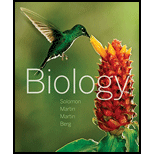
Concept explainers
Which of the following is the most fundamental feature that enables the cell to function as a distinct entity, separate from its environment? (a) nucleus (b) ribosomes (c)
(d) plasma membrane (e) protein
Introduction: Cells are the fundamental unit of life. They are modified in different ways to carry out various functions. Prokaryotes are single-celled organisms, and eukaryotes are mostly multicellular organisms.
Answer to Problem 1TYU
Correct answer: The most fundamental feature that enables the cell to function as a distinct entity, separate from its environment, is plasma membrane. Hence, the correct answer is option (d).
Explanation of Solution
Reason for the correct answer:
The plasma membrane, also called selectively permeable membrane, is the rigid boundary that separates the extracellular niche and the intracellular components. It is present in both prokaryotic cells and eukaryotic cells. The plasma membrane has pores that allow the movement of molecules across the lipid bilayer from the extracellular matrix to the interior of the cell or vice versa. It is made up of phospholipid bilayer that is embedded with proteins, carbohydrates, and cholesterol. The membrane barriers present outside the cell will maintain the chemical environment inside the cell. The internal composition of the cell is maintained only when the cell is separated from the outside environment.
Option (d) is given as “plasma membrane”.
Plasma membrane is also called as selectively permeable membrane, as it allows the entry of only selected particles to move inside and outside of cell.
Hence the correct answer is option (d).
Reasons for incorrect answers:
Option (a) is given as “nucleus”.
Nucleus is a cellular organelle present within eukaryotic cells. They do not permit the cell to function as a distinct entity, separate from its environment, as they are not selectively permeable.
Hence, option (a) is incorrect.
Option (b) is given as “ribosomes”.
The ribosomes are organelles that comprise proteins and ribonucleic acid (RNA). The ribosomes are associated with the synthesis of proteins. They do not separate the cell from its external environment.
Hence, option (b) is incorrect.
Option (c) is given as “nucleic acids”.
Nucleic acids are the biochemical entities that mainly constitute RNA or DNA as the genetic material. They do not separate the cell from its external environment.
Hence, option (c) is incorrect.
Option (e) is given as “protein”.
Protein is a biomolecule that is made of repeating subunits of amino acids. They do not separate the cell from its external environment.
Hence, option (e) is incorrect.
Hence, the options (a), (b), (c), and (e) are incorrect.
The plasma membrane is the boundary between the cell and its outer environment.
Want to see more full solutions like this?
Chapter 4 Solutions
Biology (MindTap Course List)
- Explain how the hormones of the glands listed below travel around the body to target organs and tissues : Pituitary gland Hypothalamus Thyroid Parathyroid Adrenal Pineal Pancreas(islets of langerhans) Gonads (testes and ovaries) Placentaarrow_forwardWhat are the functions of the hormones produced in the glands listed below: Pituitary gland Hypothalamus Thyroid Parathyroid Adrenal Pineal Pancreas(islets of langerhans) Gonads (testes and ovaries) Placentaarrow_forwardDescribe the hormones produced in the glands listed below: Pituitary gland Hypothalamus Thyroid Parathyroid Adrenal Pineal Pancreas(islets of langerhans) Gonads (testes and ovaries) Placentaarrow_forward
- Please help me calculate drug dosage from the following information: Patient weight: 35 pounds, so 15.9 kilograms (got this by dividing 35 pounds by 2.2 kilograms) Drug dose: 0.05mg/kg Drug concentration: 2mg/mLarrow_forwardA 25-year-old woman presents to the emergency department with a 2-day history of fever, chills, severe headache, and confusion. She recently returned from a trip to sub-Saharan Africa, where she did not take malaria prophylaxis. On examination, she is febrile (39.8°C/103.6°F) and hypotensive. Laboratory studies reveal hemoglobin of 8.0 g/dL, platelet count of 50,000/μL, and evidence of hemoglobinuria. A peripheral blood smear shows ring forms and banana-shaped gametocytes. Which of the following Plasmodium species is most likely responsible for her severe symptoms? A. Plasmodium vivax B. Plasmodium ovale C. Plasmodium malariae D. Plasmodium falciparumarrow_forwardStandard Concentration (caffeine) mg/L Absorbance Reading 10 0.322 20 0.697 40 1.535 60 2.520 80 3.100arrow_forward
- please draw in the answers, thank youarrow_forwarda. On this first grid, assume that the DNA and RNA templates are read left to right. DNA DNA mRNA codon tRNA anticodon polypeptide _strand strand C с A T G A U G C A TRP b. Now do this AGAIN assuming that the DNA and RNA templates are read right to left. DNA DNA strand strand C mRNA codon tRNA anticodon polypeptide 0 A T G A U G с A TRParrow_forwardplease answer all question below with the following answer choice, thank you!arrow_forward
 Concepts of BiologyBiologyISBN:9781938168116Author:Samantha Fowler, Rebecca Roush, James WisePublisher:OpenStax College
Concepts of BiologyBiologyISBN:9781938168116Author:Samantha Fowler, Rebecca Roush, James WisePublisher:OpenStax College Human Physiology: From Cells to Systems (MindTap ...BiologyISBN:9781285866932Author:Lauralee SherwoodPublisher:Cengage Learning
Human Physiology: From Cells to Systems (MindTap ...BiologyISBN:9781285866932Author:Lauralee SherwoodPublisher:Cengage Learning Biology (MindTap Course List)BiologyISBN:9781337392938Author:Eldra Solomon, Charles Martin, Diana W. Martin, Linda R. BergPublisher:Cengage Learning
Biology (MindTap Course List)BiologyISBN:9781337392938Author:Eldra Solomon, Charles Martin, Diana W. Martin, Linda R. BergPublisher:Cengage Learning Human Biology (MindTap Course List)BiologyISBN:9781305112100Author:Cecie Starr, Beverly McMillanPublisher:Cengage Learning
Human Biology (MindTap Course List)BiologyISBN:9781305112100Author:Cecie Starr, Beverly McMillanPublisher:Cengage Learning





